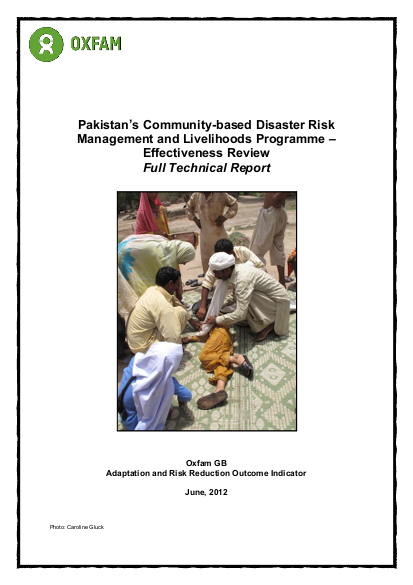
Under Oxfam Great Britain’s (OGB) Global Performance Framework (GPF), sufficiently mature projects/programmes are being randomly selected each year and their effectiveness rigorously assessed. Pakistan’s Community-based Disaster Risk Management and Livelihoods Programme was randomly selected for an Effectiveness Review under the adaptation and risk reduction (ARR) thematic area. The review focused on the work carried out by two of Oxfam’s partner organisations – the Doaba Foundation and the Help Foundation – in Muzaffargarh and Rajanpur districts of Pakistan’s Punjab Province. Over 21,700 people residing in 60 villages of these two districts are being reached through the programme. These people are exceptionally vulnerable to extreme flooding events, given that they reside directly on the floodplains of the Indus and Chenab rivers. And the overall aim of the programme is to reduce their vulnerability, particularly by reducing loss of life and assets and promoting livelihood resilience in times of extreme flooding.
To assess the effectiveness of the programme on reducing risk and promoting adaptive capacity in particular, a quasi-experimental impact evaluation design was implemented. This involved administering surveys to representative samples of 341 households residing in 57 villages targeted by the programme and 400 other households residing in 63 similar villages in adjacent areas that were not. Propensity score matching (PSM) and multivariable regression (MVR) were subsequently used in the statistical analysis of the data to reduce bias in the resulting comparison of these two groups. Two key areas of interest were investigated through this process: the extent the supported and unsupported households a) possess characteristics that are assumed important for successfully coping with and recovering from extreme flooding events, as well as adapting to emerging climatic trends and uncertainty; and b) were affected by the extreme floods that hit Pakistan in July to September 2010.
A number of large and positive differences were identified between the supported and unsupported households. Overall, the supported households scored more positively on most of the ‘resilience’ characteristics. There is also strong evidence that they experienced less asset and related loss during the 2010 floods. One particularly noteworthy finding is that the supported households were actually poorer in terms of asset ownership before the programme began but were found to be better off at the time of the assessment exercise. The respondents from the supported villages were also found to be more aware of their villages’ disaster management plans and had participated more in disaster preparedness meetings. There is no indication, however, that the programme positively affected livelihood diversification and motivation among the supported households to pursue alternative livelihood strategies. Nevertheless, there is very strong evidence that the programme generated positive changes in terms of reducing flood-related risk.
